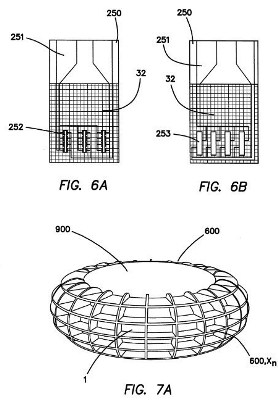Pharmaco-Kinesis Corporation (PKC) announced today the filing of a US patent application entitled "Carbon Nanotube BioFET with a Local Amplifier in a System Array for Analysis of Biomarkers and Method of Analysis of Same."

ACARB(TM) BioFET Chip 3-D Configuration
The new biosensor technology solves how to reliably measure the degree and time sequencing of a plurality of biomarkers, such as those found in cellular protein signaling pathways, and in a way that the degree and time sequencing of the plurality of protein biomarkers in a live cell is mimicked and resolved. The technology was invented by PKCs Co-Founder and Chief Innovation Officer, Josh Shachar. The biological field effect transistor (BioFET) sensor array replaces a conventional field-effect transistor (FET) by formation of a bio-functionalized layer of immobilized probes formed out of carbon nanotubes that act as surface receptors to attenuate the gate. The motivation for the invention of this newly formed Analogue Circuit Integrated, Nanofabricated, Carbon Nanotube Based BioSensor (ACARB™) BioFET was Shannon, CE.1941.paper "Mathematical Theory of the Differential Analyzer," which set the vision of analog computation as a better analytical tool modeling, as it resembles the physical laws and where computation is realized. Reaction-diffusion computation is an important example of continuous-time analog computing within the framework of a biological field effect transistor.
The analog operational circuits that are assimilated into the analog computational analyzer for use in the application incorporating the principles of cellular BioFET array enable a parallel computing paradigm similar to neural networks. An analog interface is applied in order to solve the diffusion as well as the hybridization problem for a variety of proteins and DNA captured by the BioFET in a manner that cellular biological process-dynamics is mimicked, and by which the underlying protein sequences observed in an array of such devices can be counted and thereafter certain arithmetical procedures applied. By using this newly formed transistor, the analog interface is well suited for solving partial differential equations (PDE), specifically non-linear differential equations and systems of equations required in mimicking the biological processes. The analog computation unit is comprised of circuits that can perform addition, subtraction, multiplication, division, integration, and differentiation, thereby enabling the apparatus to reliably mimic the stochastic-statistical nature of the underlying electrochemical processes that ultimately provide a realistic ground for investigations of biological sequences.
"PKC seeks to transform medical practice away from reactive medicine to proactive prevention through real time, continuous cloud-linked bio-monitoring driven by the companys innovative SMART™ (Simultaneous Multiplexed Automated Real Time Telemedicine) platform. The BioFET sensor reflects an important step toward our achieving this goal. Additional important applications of PKCs biosensor technologies are food safety testing, environmental monitoring and military biodefense testing," said Frank Adell, Chief Executive Officer. PKC is the recipient of prestigiousFrost & Sullivan awards for New Product Innovation in 2013 and Best Practices in 2014.
"BioFET cells offer a major advance over gravimetric, galvanometric, optical, radiometric or acoustic biosensors," said Josh Shachar. "The cellular BioFET array allows the realization of an automated sampling device that enables a quantitative detection mechanism based on an electrochemical binding of circulating analytes to immobilized antibodies on the carbon nanotube surface."
Understanding and measuring the levels of biomarkers in a patient is a critical step in disease diagnosis and monitoring, before and during treatment and for monitoring of disease recurrence after remission. Standard methods for such testing can be time-consuming and often require use of sensitive antibodies, fluorescent labeling and optical imaging techniques. Individual tests may cost $600-1,000 and 24-48 hours can pass before the results are available to the physician. Such time-consuming and expensive testing procedures contribute to rising health care costs, prolonged hospitalization and added stress for the patient. Recent innovations in new biosensor technology offer real hope that physicians will be able to soon achieve real-time, point-of-care practice in the near future. Such technology would also help improve the cost and delivery of health care overall.
Said Frank Adell, "PKC has engaged in development of its ACARB™ technology platform since 2010. The BioFET chip represents the result of over five years of research and development during which period we have transferred 2-D chip production from a lithography technique to a printable flexible generation of the ACARB™ chip, and now onto the BioFET version. Our first generation products that use the 2-Chip are about one year away from entering the commercial market. Filing the IP for ACARB BioFED 3-D chip is a great accomplishment and a major milestone since the 3-D BioFET could pave the way to production of a new generation of devices for protein sequencing that are the size of an iPhone and cost only a few hundred dollars. We are excited since yet one of biggest applications of the 3-D ACARB BioFET sensor is in the realm of the Internet of Things (IoT). The IoT really transports the connection of sensors. The ACARB™ BioFET chip has the cloud-linked sensing capability that the IoT needs in order to breath and flourish and for sensor to communicate. The ACARB™ BioFET chip for first time enables us to link the biology directly to computer binary language in real time, and through the IoT. BioFET is yet another important advance in the companys armament of novel biosensor technologies. It augments the SMART™ platform for point-of-care and personalized medicine and will find application across a host of disease conditions, as well as in other biological measurements."

